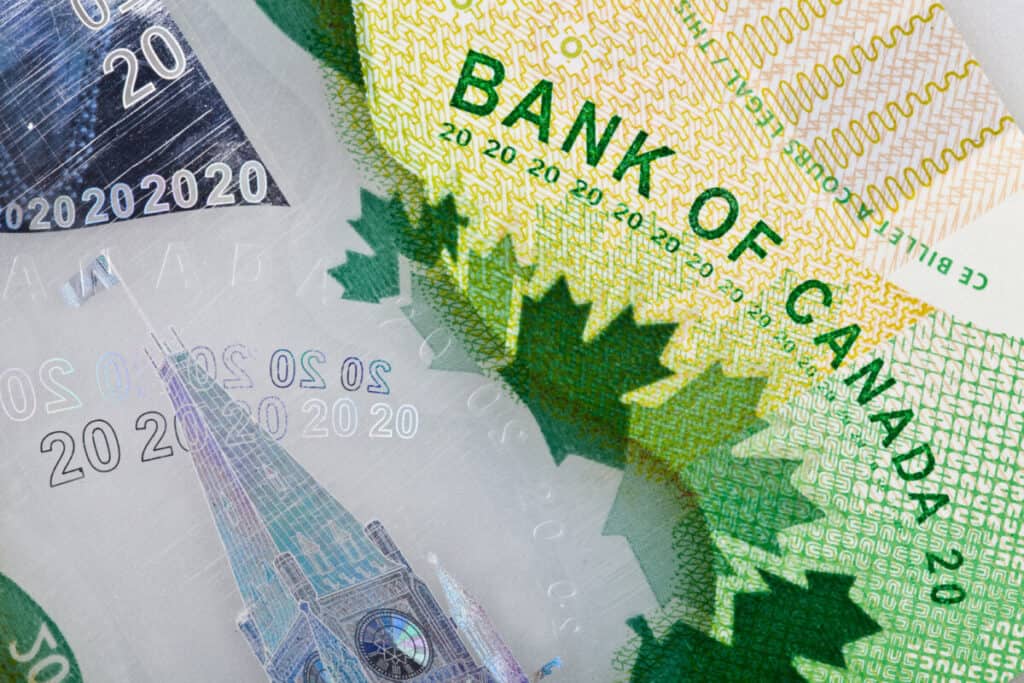
Everyone wants to get the most they can get out of their money and their investments. However, because there are so many options, it can be difficult to decide what banks you should create an account with. How do interest rates work for banking accounts in Canada?
Interest rates for savings accounts vary by bank. In Canada, there are traditional interest rates, which are below 1%. However, Canadian banks also offer High-Interest Saving Accounts, which offer a much higher interest rate, 1-1.75%, allowing money to grow at a faster rate.
In this article, we’ll discuss both types of savings accounts. Both perform the same function of holding your money and protecting it, in the event a financial catastrophe occurs. We’ll also discuss the common misconception of a Tax-Free Savings Account and what its actual function is.
Determination of How Interest is Applied to Savings Accounts
In Canada, there are multiple ways that you can earn interest on your money. Each bank can choose between three different methods for how they apply their rate of interest to your savings account.
First, a Canadian bank can decide whether they apply the interest rate to all of the money in your account. This means that you will start gaining compound interest every month, no matter how small your amount of savings is. As your money grows, the amount of interest that you earn will grow as well.
Second, compound interest can also be applied once your money hits a certain threshold. Some banks require a minimum amount of money in the savings account before it begins to earn compound interest. This does not mean that you have to put in that minimum amount to open an account with that bank; it simply means that you will not earn interest on your money until it hits that threshold.
Third, compound interest can be applied to only part of your money. This interest will be applied to the amount that goes over a minimum threshold. For example, if the minimum threshold to earn compound interest is $500, you will only begin to earn interest on whatever money you put in your account from that point forward. The $500 acts as an incentive to keep adding money so that you can continue to gain compound interest on it.
Savings Accounts
Basically, traditional savings accounts function in a very similar manner to American ones. You open an account with a local credit union, bank, or online bank. As you continue to put money into your savings account, you will earn interest every month. This is based on the interest rate the bank sets. This interest rate is typically below 1%. This percentage is broken up and this new rate is used to determine what interest you earn every month.
For example, if your bank has set a compound interest rate of 0.01%, which is a typical base rate, this means that every month you will be earning 0.00083% on whatever amount you have in your savings account. If you had $1000 ($738 UD) in your savings account, you’ll earn $0.83 (0.66 USD) of interest for that month. This means that after one year if you still have $1000 in your account, you will have incurred $10 (7.38 USD). Obviously, life happens and you will add and remove money, which means that the amount of money that will be in your savings account will change.
The amount of money that you are going to earn from a traditional bank is going to be very low. If you want to capitalize on the amount of interest you can get for your money, a traditional savings account is not going to be the way to do it. It is better than hiding your money under your bed in a beaten-up shoebox, but you’re not going to get that much extra money from an account like this.
High Savings Accounts (HISAs)

Canadian banks also give you the option to open a high savings account (HISA). These HISAs have a higher rate of interest and also apply compound interest to your deposit. However, it is important to note that the higher interest rates that are available are subject to change. HISAs have a higher interest rate that ranges from 0.5-3.0% (These numbers were taken before the hit of Covid-19; most banks now have their highest interest rate set at 1.75%).
No matter what the rate of interest a HISA has, the biggest benefit is that it helps to match the rate of inflation. In a typical savings account, the interest rate is so minimal that your money begins to lose its value. The rate of inflation is such that it is impossible for that money to still have the same value as it did when you put it in. Another great benefit is that your money begins to grow more rapidly. You will begin to earn better interest on the interest the bank is putting into your account.
Additionally, some banks offer promotional deals with their HISAs. What this means is that the interest rate will be high for a set period of time. However, once that period of time is over whether it is a month or four- the interest rate will be dropped to a much lower one, such as 0.5%.
You can find HISAs as options in credit unions, physical banks, or solely online banks. All three options come with different benefits and drawbacks. A physical bank, for example, might have a set amount of withdrawals you can make during the month. If you go over that amount, a small fee will be applied. Or you may only be able to open a HISA with that bank but you won’t be able to open a checking account.
Online Banks
You might feel skeptical about putting your money into an online bank. It makes sense because it can be difficult to know whether your money will be protected or not. The critical thing to look for on an online bank is a small caption stating that the bank is covered by the CDIC (Canadian Deposit Income Corporation). This is something that you should be looking for regardless of what type of bank or credit union you decide to open a HISA with. The CDIC helps to protect whatever money you put into your account.
If there is a crisis at the bank or credit union you have opened an account with, the CDIC will be able to reimburse you for that amount of money, up to $100,000. It is an insurance policy to help you feel secure about opening an account with a financial institution, but it also acts to help that financial institution gain investors like you. So, as long as you see that the financial institution is covered by the CDIC, your money is safe. Some provinces might have a different acronym for the corporation that protects your money, such as the ones in Ontario.
Rates and Sustainability
Before Covid-19, the B2B Canadian bank advertized a HISA account with an interest rate of 3.3%. Obviously, this is quite high and could allow you to earn quite a bit of interest for what you deposit in that savings account. However, an interest rate of 3.3% is not very sustainable for the market. Although the interest rate might be high for a period of time, it is likely to drop to a much lower rate.
This is a perfect example for talking about interest rates and their sustainability. Even though a financial institution may offer a high interest rate for their HISAs, it does not mean that it is sustainable. It could be set at that rate for a short period of time, but as the financial market changes, the interest rate is also going to change. The EQ Bank has set its HISA interest rate at 2.3% (pre-Covid; the rate has now changed to 1.7%). Although this is lower than the rate B2B was offering before Covid, it is much more constant.
Having a consistent rate of growth for your money is going to have a much greater impact on what you earn than having periods of high interest and low interest rates. However, the type of spending that you want to do is going to impact your choice. It is important to consider the financial goals you have, the sustainability of the interest rate, and if it is secured by the CDIC when you are choosing the financial institution you want to open a HISA with.
Tax-Free Savings Accounts (TFSAs)
The common misconception about tax-free savings accounts (TFSAs) is that it is a savings account. Although you are earning interest on the account, It is an account where you place your investments to prevent them from being taxed. You can place your investments in stocks, bonds, cash, and REITs in this account. Similar to Roth IRA account for Americans, a TFSA is typically used to save revenue for when you retire.
The amount of money that you contribute to your TFSA is determined by your age. If you were born in the 1990s, the cap for the amount of money that you can invest in a TFSA will be less than someone born in the 1970s. Even though it is called a TFSA, it is more accurate to think about this account as a place where you put your investments to protect them from taxes. They will continue to grow, but they act in a very different capacity to savings accounts and HISAs.
Banks in Canada

Now that you understand the different types of savings accounts financial institutions offer in Canada, we’ll go over some of the different banks that exist. We’ll also explore how these banks apply interest rates to their accounts. This we’ll give some better options of what bank you might want to go with when you decide to open a savings account.
The Big Five
In Canada, there are the big five financial institutions: the Royal Bank, the Bank of Montreal, the Canadian Imperial Bank of Commerce, the Bank of Nova Scotia, and The Toronto-Dominion Bank. All of these banks are similar in the way they function. Although they are the most well-known and have the most credence, the interest rates on their HISAs are some of the lowest.
The Royal Bank of Canada offers a high-interest rate of 0.5%, which, as discussed earlier in the article, is the lowest rate that a HISA can have. The Bank of Nova Scotia offers an interest rate of 0.5% as well for its HISAs. They do have more promotional deals that are applied to this rate, but it is still the lowest high-interest rate for a HISA.
The Big Five also apply the small fees that can be applied with different withdrawals. They also apply fees for basic transactions that you might need to make within and out of your HISAs. Although they are small, they can add up quickly over time which lessens the amount of interest you earn on what you have put in the bank.
Other Banks and Credit Unions
Of course, if you don’t want to open an account with one of the Big Five, you can look for a more local credit union or bank. Or, you can go completely online for your savings account. The EQ Bank discussed earlier, is starting to become a more popular option. Its interest rate for its HISAs is currently 1.7%, which is higher than the Big Five and more sustainable. It is an e-bank, which may be a drawback if you enjoy going into a physical bank. However, a great benefit of the EQ Bank is that they do not apply the small fees for making transactions and withdrawals from your accounts.
Other banks or credit union options include Achieva Financial, Tangerine, Wealthsimple, and SavySavings. These all offer higher interest rates than the Big Five. Most do not apply fees for making multiple transactions within a month or for withdrawing money multiple times. A few banks do offer a card that you can use as if you had a checking account.
No matter what bank or credit union you decide to open an account with, you must do your research. Take time to learn about the different financial benefits or drawbacks it has. It is also important to assess what financial goals you want to achieve in your future.
